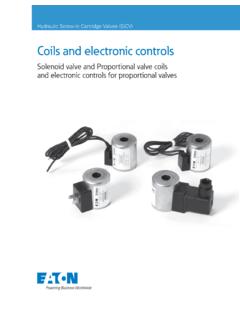Transcription of Industrial flow meters/flow transmitters - TI.com
1 29 Analog Applications JournalTexas instruments Incorporated2Q 2012 High-Performance Analog ProductsGeneral InterestIndustrial flow meters /flow transmittersIntroductionFlow meters are an integral tool for measuring the flow of liquid, gas, or a mixture of both in applications used in the food and beverage industry, oil and gas plants, and chemical/pharmaceutical factories. There are many differ-ent types of flow meters available on the market. Fluid characteristics (single or double phase, viscosity, turbidity, etc.), flow profile (laminar, transitional, or turbulent, etc.), flow range, and the need for accurate measurements are key factors for determining the right flow meter for a par-ticular application.
2 Additional considerations such as mechanical restrictions and output-connectivity options also impact this choice. The overall accuracy of a flow meter depends to some extent on the circumstances of the application. The effects of pressure, temperature, fluid, and dynamic influences can potentially alter the measurement being flow meters are used in environments where noise and sources of high-voltage surges proliferate. This means that the analog front end (AFE) needs to operate at high common-mode voltages and have extremely good noise performance, in addition to processing small electri-cal signals with high precision and repeatability.
3 The 4- to 20-mA loop is the most common interface between flow transmitters and flow-control equipment such as program-mable logic controllers. Flow transmitters can either be powered by this loop or have a dedicated power line. Flow transmitters designed to use the loop have extremely stringent power constraints, as all of the electronics for signal acquisition/processing and transmission may need to operate solely off the 4- to 20-mA loop. Ultra-low-power processors such as the texas instruments MSP430 and TMS320C5000 DSP families, in conjunction with high-precision, low-power AFE solutions, are commonly used in loop-powered transmitters .
4 transmitters with digital- connectivity features such as a process field bus (PROFIBUS), I/O links, and/or wireless connectivity are increasingly popular, as they reduce start-up times and provide continuous monitoring and fault diagnostics. All these factors greatly improve productivity and efficiency of the automation article provides an overview of the working opera-tion of the four most common flow meters : differential-pressure, electromagnetic (magmeter), Coriolis, and ultrasonic, the last of which includes Doppler-shift and transit-time flow meters . The key uses of these meters are presented along with their advantages/disadvantages and system flow meterThis meter operates based on Bernoulli s principle.
5 It mea-sures the differential-pressure drop across a constriction in the flow s path to infer the flow velocity. Common types of differential-pressure flow meters are the orifice, the pitot tube, and the venturi tube. An orifice flow meter (Figure 1) is used to create a constriction in the flow path. As the fluid flows through the hole in the orifice plate, in accord-ance with the law of conservation of mass, the velocity of the fluid that leaves the orifice is more than the velocity of the fluid as it approaches the orifice. By Bernoulli s princi-ple, this means that the pressure on the inlet side is higher than the pressure on the outlet side.
6 Measuring this differ-ential pressure gives a direct measure of the flow velocity from which the volumetric flow can easily be considerations for differential-pressure flow meters Robust and mature technology with easy maintenance (no moving parts) Suitable for turbulent flow Poor accuracy for low-flow measurements Uses extractive flow-measurement technique, so there is always a permanent pressure loss that must be over-come with extra pumping energy Requires strict placement of pipe fittings, elbows, and bends for downstream and upstream constriction tapsBy Deepa KalyanaramanBusiness Development Manager, End-Equipment SolutionsP2P1 OrificeFigure 1.
7 Differential-pressure orifice flow meterTexas instruments Incorporated30 Analog Applications JournalHigh-Performance Analog Products 2Q 2012 General InterestElectromagnetic flow meter (magmeter)The electromagnetic flow meter, also known as a magmeter, is based on Faraday s law of electromagnetism and can be used to measure the flow only of conductive fluids. Two field coil magnets are used to create a strong magnetic field across a pipe (Figure 2). Per Faraday s law, as the liquid flows through the pipe, a small electric voltage is induced. This voltage is picked up by two sensor electrodes located across the pipe.
8 The rate of fluid flow is directly propor-tional to the amplitude of the electric voltage considerations for electromagnetic flow meters (magmeters) Can measure only fluids with conductivity greater than 10 S/cm, eliminating their use in the petroleum, oil, and gas industries, since hydrocarbons have poor conductivity Sensor-electrode choices change depending on fluid conductivity, pipe construction, and type of installation No losses in system pressure, which may be critical in applications that cannot tolerate pressure drops, such as applications with low-velocity flow Ideal for corrosive and dirty fluids, slurries, etc.
9 , pro-vided the liquid phase has sufficient conductivity, since the flow meter has no internal parts High accuracy to within 1% of indicated flow Higher costCoriolis flow meterThis popular flow meter directly measures mass flow rate. The installation can include a single straight tube or, as shown in Figure 3, a dual curved tube. The architecture with a single straight tube is easier to construct and main-tain because it is subject to fewer stress forces, but it is susceptible to interference and noise. The architecture with dual curved tubes cancels out any noise picked up because the two tubes oscillate in Coriolis meters , the tubes through which the fluid flows are made to oscillate at a particular resonant frequency by forcing a strong magnetic field on the Figure 3.
10 Coriolis flow meterFC (Coriolis force) = 2mwvrm = Moving massw = Speed of rotationvr = Radial velocityFlowe BFigure 2. Electromagnetic flow metereq (voltage) = dFB/dtB = Magnetic fieldThe coils used to create the magnetic field can be excited with AC or DC power sources. In AC excitation, the coils are excited with a 50-Hz AC signal. This has the advantage of drawing a smaller current from the system than the DC excitation technique. However, the AC excita-tion method is susceptible to interference from nearby power cables and line transformers. Thus, it can introduce errors into the sig nals measured.














